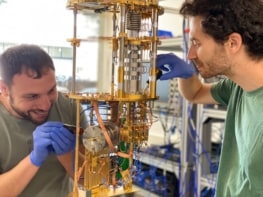
A new way to create and guide beams of “twisted light” has been created by researchers in the UK. The team used a cylindrical array of ultrasound loudspeakers to create a pattern of density waves in a fluid through which a laser beam is shone. The system creates twisted “Bessel beams” that can be reconfigured at a rate of about 150 kHz and shows promise for use in a wide range of applications including optical tweezers, high-speed data transmission and aberration correction for microscopes.
Twisted light refers to a beam with a wavefront that rotates around its direction of propagation with a corkscrew-like motion – and therefore carries orbital angular momentum. Bessel beams are a type of twisted light that have been created in the lab using special lenses and have been used in optical tweezers. An important feature of Bessel beams is that they do not diverge as they propagate, which makes them well-suited for optical tweezers.
Concentric waves
In 2006 Craig Arnold and colleagues at Princeton University created “zeroth order” Bessel beams using ultrasonic standing waves. The waves create concentric regions of high and low density in a fluid held in a cylindrical container. The optical refractive index of a fluid increases with the fluid’s density and therefore the fluid behaves as a complicated lens, which focuses a conventional laser beam into a Bessel beam.
An important feature of this “acousto-optic” device is that it can be reconfigured at a rate of about 1 kHz. This means the Bessel beam to be used for manipulating particles in optical tweezers, for example. However, the beam could not be steered and higher-order Bessel beams – those carrying angular momentum – could not be made. Other researchers have used liquid crystal-based spatial light modulators to create a wider variety of twisted light, including Bessel beams. This approach can also achieve reconfiguration rates up to about 1 kHz, but faster rates would allow twisted light to be used in a broader range of applications.
Now a team led by Bruce Drinkwater at the University of Bristol and Mike MacDonald at the University of Dundee have created a new acousto-optic device that can create and steer higher-order Bessel beams with the added bonus of a fast reconfiguration rate.
No reflections
At the heart of the system is an array of 64 tiny piezoelectric loudspeakers that are arranged on the inner wall of a short tube with an inner radius of about 5.5 mm. The tube is filled with water and capped at both ends by glass slides that are transparent to light, creating a cylindrical lens. A crucial feature of the inner wall of the tube is that it absorbs the ultrasound that impinges on it, rather than reflecting the ultrasound back into the water. This means that there are no resonant standing waves within the chamber and this allows the output from the loudspeakers to be used to create much wider range of wave patterns than Arnold and colleagues could achieve. Indeed, the patterns need not be centred on the cylinder’s axis of symmetry and this allows the centre of beam to be scanned across the plane of the cylinder.
A beam of laser light is passed through the device and the emerging Bessel beam is captured by a digital camera for analysis. The researchers were able to observe Bessel beams of the first to fourth order as they adjusted the amplitudes and relative phases of the loudspeakers. They were also able to raster the position of the centre of the Bessel beam a distance of ±0.2 mm in both the x and y directions.
The non-resonant nature of the device also plays a role in its rapid reconfiguration. Because a sound wave only travels across the cylinder once – rather than bouncing back and forth many times – the time needed to change the shape of the lens is simply the time it takes a sound wave to travel across the cylinder. In this latest device the maximum reconfiguration rate is about 150 kHz. However, Drinkwater and colleagues point out that if the lens is made from a solid material such as lithium niobate – with a much faster speed of sound than water – then a reconfiguration rate of about 1.5 MHz could be achieved.
Applications are everywhere
“The number of applications of this new technology is vast,” says Drinkwater. “Optical devices are everywhere and are used for displays and communications, as well as scientific instruments.”
One possibility is to use the device to encode information into the orbital angular momentum states of light pulses. This could allow pulses of the same colour light, but with different orbital angular momentum states, to transmit data simultaneously along the same optical fibre, thereby boosting the data transmission rate.
Other applications of Bessel beams include optical tractor beams that can pull objects towards a light source and the “photoporation” of living cells, which makes use of the non-diverging nature of a Bessel beam to punch a tiny hole in the cell membrane. Adaptive optics for optical microscopes, which would perform the real-time correction of images for the effects of aberration, is another possible application.
The research is described in Optics Express.
- Last year Hamish Johnston visited Bruce Drinkwater’s lab at the University of Bristol to learn about the physics of ultrasound. You can listen to his conversation with Drinkwater and watch a short video about ultrasonic levitation here: “The wonderful world of ultrasound“.



